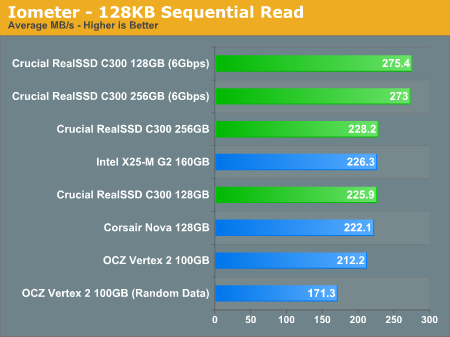The SSD Diaries: Crucial's RealSSD C300
by Anand Lal Shimpi on July 13, 2010 12:39 AM ESTSequential Read/Write Speed
Using the 6-22-2008 build of Iometer I ran a 3 minute long 2MB sequential test over the entire span of the drive. The results reported are in average MB/s over the entire test length.

Sequential read performance is a virtual tie across the board, the exception being if you have totally random data on a SandForce drive. In that case the Vertex 2 is noticeably behind the competition. Pair the C300 with a 6Gbps controller and it has a clear advantage - you get a 20% increase in sequential read speed from the C300.

Sequential write speed is strong on the C300, but mostly if you look at the 256GB drive. The 128GB C300 is 30% faster than Intel’s 160GB X25-M G2, but no where near the peak speed of OCZ’s Vertex 2. The random data test has the Vertex 2 and C300 a lot closer, but in reality I’d expect the Vertex 2 to be a bit quicker than the 128GB C300 in sequential write speed. The 256GB C300 should be at least as fast as the Vertex 2 in practice, if not faster. Once again we see the odd situation where our 256GB C300 paired with a 6Gbps controller actually drops performance a bit here. There must be a driver optimization issue with 4K aligned, 128KB sequential writes because the same problem doesn't present itself with unaligned 2MB sequential writes. Unfortunately for Marvell/Crucial, this test is more representative of how modern OSes write sequential data.
Looking at our synthetic tests alone it seems that the C300 is very competitive with SandForce. It boils down to the workload more than anything else. The C300 is clearly in the run for first or second place.










51 Comments
View All Comments
strikeback03 - Tuesday, July 13, 2010 - link
Really? I have 3 computers, and can see a use for the 30-40GB, 60-80GB, and 100+GB size drives depending on which system I am thinking of. For my HTPC, a small drive would be fine, all it holds is the OS. For my desktop, I have an 80GB X25G2, as IMO a smaller drive would be iffy when 2 operating systems are installed on the drive, and allowing for extra spare area. For my laptop I wouldn't consider anything under 100GB, as I don't want to have to carry a separate external drive to store stuff to.erple2 - Tuesday, July 13, 2010 - link
I'll second that - my laptop has the 160 gig Intel G2 drive in it because I have installed slightly more than the OS on it (a few steam games + WoW = need more than 80 gig).I don't need more than about 120-160 gigs on my laptop (that's what my home server is for). My desktop would be in the same boat - I'd need enough "space" to install some large applications on it plus the OS.
I've heard people recommend that you should install applications on spindle drives, but the reality is that some of those applications are very slow loading on a spindle drive.
Personally, I don't care if my OS takes 5 minutes to boot. I almost never shut down anyway.
neoflux - Tuesday, July 13, 2010 - link
Fantastic article as always, Anand. Informative, investigative, and conclusive. I couldn't ask for anything else ( other than the funds to purchase a Vertex 2 :P ).Slaimus - Tuesday, July 13, 2010 - link
With such a large DRAM cache, is there greater risk of data corruption when there is a power outage or power supply failure?Anand Lal Shimpi - Tuesday, July 13, 2010 - link
Crucial claims to store very little user data in the external DRAM, it's mostly to give the firmware room to store mapping tables and history data to make better decisions about how to organize future writes.Take care,
Anand
GourdFreeMan - Tuesday, July 13, 2010 - link
Have you ever actually put this to the test, though?Intel claims they do the exact same thing with their DRAM, yet I have had applications that were not in use become corrupt after a sudden power loss (i.e. bluescreen after resuming from hibernation, cat depressing laptop power button) on my Intel G2 drives. The mechanical drives that were in the exact same system prior to being replaced by SSDs only lost minimal amounts of data (and typically only the data in use at the time) under the exact same power loss scenarios.
Echo147 - Tuesday, July 13, 2010 - link
My first SSD - And it couldn't be picked up after just 5 hours. Pretty crushed :sIt'd been shipped with Firmware 0001 which I'm guessing was a large oversight by Crucial or the retailer. I wasn't about to go flashing a £500 drive, so it's in RMA as we speak.
Will be waiting for Intel's 25nm offerings before dipping my burned toes again...
greggm2000 - Tuesday, July 13, 2010 - link
Anand,Are there any plans to test these drives in RAID configuration? You've already done so with Intel's cheapest value drive, but for those of us who are considering in the higher end drives, it would be interesting to know such things as will a pair of Crucial RealSSD 128GB drives on SATA outperform a single 256GB on SATA 6Gb... or even how well 4 of the 64GB drives compare as well. Also, how do the Sandforce drives compare in RAID to the others.
Thanks! Great article as always!
mckirkus - Tuesday, July 13, 2010 - link
Just to get a sense of what is used by most humans (hard drives, not VRaptors).Alkapwn - Tuesday, July 13, 2010 - link
Do SandForce controllers suffer when BitLocker is enabled? I'm guessing there would be less predictable data patterns for it's controller to use, and thus might be slower? Would that then solidly put the lead in Crucials favor?